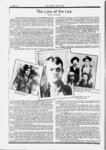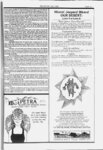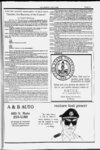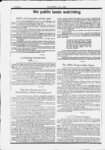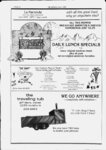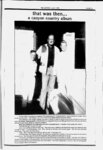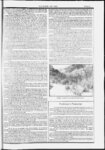| OCR Text |
Show i- Sr. "'A THE ZEPHYR JULY 1990 : r.-- 't - Anasazl Ruins, so Indian Creak was scrapped. We decided not to bum Indian Creek, due to concerns about the ruins and Impacts to visitors that use the mouth of the Indian Creek for camping. An Island was chosen upstream of Indian Creek at the mouth of Lockhart Basin. The Island was approximately 70 covered In tamarisk. The fire prescription was to bum In March and only If high water flow, If I remember correctly, reached at least 40,000 CFS on the Green River. The bum would only occur If there was a predicted high water that would flood the bum site. Snow pack In the Rocky Mountains for the spring of 1985 was similar to 1983-198- 4. Forecasters were expecting another high water flow. The stage was set In late March, two and two set off to bum the site on the Green River. We put In at Potash and began motoring down the Colorado River In a Zodiac. The wind was fierce that day, creating whltecaps that caused the Zodiac to bounce so hard I bit my tongue. This made for difficult motoring since we could not read the river and got caught numerous times on sandbars. We often had to get out of the boat and push the Zodiac off. The river water was In the 40 degree F. range, great for bare legs. By late afternoon we had made It only as far as the Confluence of the Green and Colorado Rivers, and decided to camp there. The wind at the Confluence was strong, probably gusting to 50 mph at river level, but about 500 feet above our heads the wind was screaming around the cliffs probably gusting to 100 mph. Since the confluence was the center of the Universe (It seems the center of the Universe has now shifted to a high mountain peak In Rocky Mountain National Park, where I now work), I considered the screaming wind to be a bad omen. Perhaps the spirit world was trying to tell me that by burning tamarisk I will not make "Righteous Dude status. As we were sitting around our tamarisk campfire after dark, a very strong gust of wind hit us, lifting the fire pan and Are off the ground and hurled It towards my tenL Jumping out of my chair I ran chasing the Are pan; burning wood and ash landed on my tent and started to melt my tent Ay. The Are pan and the rest of the Are proceeded down the beach and Into the river. I got the Are put out, but my tent Ay looked like swiss cheese. This Is not a good sign I said to myself, deAnltely the center of the universe Is trying to tell me something. Since I was one of those Resource Management people, whatever the wind was trying to say blew over my head, (perhaps If you or Steve had been there we would have understood). G-m- f en The next morning was cold and overcast - no tamarisk would bum In this weather, but we decided to motor up to the bum site anyway. Six miles up the Green River as we came around the bend, a hole In the clouds opened and a ray of sunshine fell onto the section of river we were to bum. A good omen Indeed I believed; the weather warmed up and we burned the tamarisk with fusees and drip torches. The Are would have made any pyromanlac happy, hundred foot Aame lengths, lots of smoke. A little less than one mile of shore burned and the north end' of the Are exposed a beautiful Aat area, suitable for a high water campsite. In April, we were going to bum the site on the Colorado River, but when we checked the Island before we burned It, I found a Canada goose sitting on ten eggs. She seemed quite upset that this bureaucrat with a drip torch was going to bum her nest However, being a bureaucrat with a heart, the Island was not burned that day and never was. To make a long story longer, the predicted high water never came that spring, and the burn on the Green River never Aooded. I was not going to make "Righteous Dude status now. Thats when I came up with the Idea of cutting the standing burned tamarisk, mostly for aesthetic reasons. I also thought If we could keep the tamarisk from maybe next year It would Aood or at least we could open a campsite up. I was a little concerned about using chainsaws along the river since It was a recommended wilderness area. I ustiAed my decision to use chainsaws because of boat traffic. Almost everyday In summer, raft trips of up to 40 people pass by the bum site most often In large rafts powered by motors, Jet boats motor up and down the rivers. Power boats go by Including the famous Friendship Cruise during Memorial Weekend, and the parks Zodiac with two fifty horse motors cruise by on patrols. The noise Is a short duration In any one spot but It Is far from quiet at certain times. When I proposed the project to the River Rangers, eyeballs rolled Into the back of their heads, moans and some words under their breath were again stated. Shortly after when Steve Mulligan was home sick, the other River Rangers drew straws, the short one losing and having to go with me, Steve lost Four of us In August armed with chainsaws motored to the burned site on the Green River. We began cutting In the early afternoon In 100 degree weather. The wood was so dry and hard our chainsaws dulled quickly. One hour of cutting, two hours went by. We were hot sweaty and covered with soot A river party went by, but skipping heart beats and sorrow, It was a canoe trip, no motors! They looked at us with a hateful stare, the other three rangers stood off to the side and pointed a finger at me, mutiny, my team left me to the vultures. We turned the saws off, feeling guilty about Infringing on their trip. Our tempers began to build, after two hours of cutting we had only advanced two hundred feet, another 4000 feet or so to go. No way were we going to get this all cut In three days, let alone one month. After about three hours off work, I cut one tree that almost four-lett- er fell on some gear of one of the other Individuals. The person let out a string of words that still bum my ears today. That did it, all our tempers broke and the two of us squared off, chainsaws running. Steve was standing there with this sick grin on his face. He apparently was hoping the other guy would take this crazy Resource Management person out Just as If It was looking like we were going to start hacking away, my chainsaw sputtered and died. Gad, out of gasl I had to start talking fast "Well, guys, I said, think this Is not going to work, maybe this Is not such a good Idea. A look of relief came across everyones faces, yes this guy sees the light We stopped cutting that day and never opened up the high water campsite. No other work was ever done with the tamarisk and the site Is now covered with tamarisk ten feet tall. I did survey the area for birds and mammals. The results were very Interesting. There were a higher number of birds using the burned area for foraging than unbumed tamarisk nearby. Small mammals were at a higher density than In unbumed tamarisk nearby. also found the tracks of a mountain lion In the bum site. I think It would be Interesting to study wildlife In a large stand of tamarisk for a couple off years and then bum It The site would then be studied for five or more years to document the changes. I suspect one would And a higher diversity and density of wildlife using the site until the trees reach a certain height and cover, and then wildlife use would dropoff. I do not work In Jim, by now you are probably crying with Joy because Canyonlands or Arches anymore. Never fear, someone will bum tamarisk, somewhere every year a fire usually escapes and bums a section of river. Since the summer of 1 985, at least a half dozen other Area have started by accident a Are that In tamarisk along both rivers, In and out of Arches and Canyonlands, Including burned a stand of cottonwood trees on the Green River and a fire that destroyed a number River. Most likely the Ares were f cottonwood trees at Spanish Bottom on the Colorado started by river runners who sitting one evening watching their tamarisk campfires got mad at that crazy Resource did that bum on the Green River. In a Management Specialist who blinding rage one of them probably Jumped up throwing their beer bottle Into the Are scattering burning coals everywhere, "Oopsl" Someone sees the results of the bum later 1 ' :'s j nffirii PAGE 27 and probably made a statement about that Resource Management Specialist still burning tamarisk. Even though I have not been In the area In three years, my legend lives on. Perhaps someday, someone will place a memorial on the sewage trailer at Hite. This Is where everyone dumps the contents of their after floating the rivers of Canyonlands. The memorial will be about this legendary Resource Management Specialist whos ghost still bums and cuts tamarisk. If I ever have the chance to work In an area with tamarisk again, I will still Initiate a program to bum and cut tamarisk. I would also take cuttings of willow and cottonwoods from existing trees along the rivers and propagate seedlings to be later transplanted onto the site. Canyonlands tried to plant cottonwood, and other riparian plants at Spanish Bottom with no success. I believe this Is probably due to the root system of other plants robbing the seedlings of moisture. Also the roots of cottonwood trees need to reach moist soil and then If the water table Is too low, the trees can only survive through supplemental watering. Cottonwoods have been established along the Colorado River In what were once tamarisk stands In California, so I know It can be done. The other Important lesson I learned was to make sure one has enough time and resources to adequately carry out a plan and follow up on It For Instance, I would have loved to have studied the bum for several years to determine use by birds and mammals. If Canyonlands and Arches National Parks do not take a more aggressive approach towards tamarisk, cottonwood trees may all but disappear from the river corridor. Clear objectives and priorities should be established for tamarisk control. Cottonwood stands are the most Important resource along the rivers and should be protected. Dense stands of tamarisk growing under cottonwood trees should be removed and controlled. New cottonwood seedlings should be propagated and planted. Camping should not be allowed to occur near cottonwood stands until the Are danger Is reduced. If an escaped campfire bums a cottonwood stand, an aggressive program of ensuring that cottonwood trees are reestablished should be Initiated by the park. Research should be devoted to burning tamarisk and monitoring use by wildlife. If more wildlife utilize a burned and regrowlng stand of tamarisk than a mature stand, the park should Initiate a burning program of burning pure stands of tamarisk every ten years or so to enhance habitat Tamarisk Is never going to be eliminated, no one will debate that subject but know It can be better managed than It Is now. Tamarisk bums, and where there are people and tamarisk, there will be Ares. The Important point Is to Insure that cottonwood trees are not destroyed. The world Is In such a chaotic state today that even If I could only get one cottonwood tree established, or enhance the habitat enough so one new pair of songbirds could establish a territory, I would call It a success. Jim, there will always be critics like yourself or Steve Mulligan on any proposal, and that Is great It Is Important to keep the cauldron stirred, but I always remember the children's story of the man that was once riding on the back of a donkey and having people criticize him because he was too big. He finally ended up carrying the donkey on his back. port-a-potti- es, I Tamarisk re-gro- wth along Colorado River after 1988 Are. Publishers Postscript The accompanying story by Jeff Connors should prove beyond the shadow of a doubt that the Zephyr will print opposing points of view. This addendum to Connors story, however, also proves that right or wrong, the publisher gets the last word. First, Jeff gives a shrug of the shoulders to the fact that the Park Service Illegally excluded the public from Its environmental assessment process. The public has the right to know what Federal land agencies are doing, and those agencies have an obligation to tell us. As for tamarisk control Itself, there Is one absolute Irrefutable fact that cannot be denied by Connors, the NPS, or anyone. Once a serious effort has been Initiated to control tamarisk - by cutting, burning, and poisoning the stumps - that effort must continue FOREVER. For eternity. Until the end of time. Jeff points proudly to his efforts In Horseshoe Canyon; If the Park Service discontinued Its yearly control efforts for Just five years, no one would ever know there had been a tamarisk eradication program. In 1988, a Are along the Colorado River In Arches burned several acres of tamarisk - burned them to a charred cinder. Today, tamarisk regrowth stands 5 to 6 feet tall (see photo). Jeffs description of his futile efforts to rid the Green River sand bars of tamarisk sound mors like a confession than an ardent defense of his tactics. Just reading It exhausted me. Jeff also mentions his concern for the cottonwoods. A proposal In 1987 to bum a massive stand of tamarisk that grew beneath cottonwoods brought protests from his own staff. A prescribed bum of tamarisk In 1985 at Death Valley resulted In the destruction by Are of several acres of precious mesqulte. Unexpected winds pushed the Are out of control. Yet Connors points to that project as a success. The fact Is, until some means of controlling tamarisk Is Introduced that Is effective, hacking away at It with a machete, a blc lighter, and a vial of poison does not seem like an efficient and worthy use of NPS money. |

















